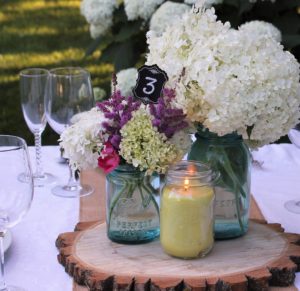
So can we all agree that tiki torches are only good for a 70s-themed pool party or a Gilligan’s Island Revival? Stinky, smoky, and unattractive, they do not belong on your gorgeously decorated deck, patio, or worse outdoor event! But they do have one redeeming quality: the bug fighting power of essential oils (yes, citronella is an essential oil). Mosquitoes just hate that lemony smell and it’s a great non-chemical, non-toxic solution to keeping our outdoor spaces bug free.
Mosquitoes hate these essential oils . . .
If you’ve been on Pinterest (or even to a grocery store these days), you’ve heard about essential oils. They seem to have downright magical properties! We couldn’t possibly list them all but we do know one thing for sure, there are a few essential oils that work fantastically to repel bugs. For centuries, folks have been using plants to deter bugs and unwanted critters. In Victorian times, herb and plant sachets were not only pretty but widely used to keep homes free of pests. But once modern science got involved, everyone turned to chemicals like DEET (which is potentially toxic to kids and pets). With the recent popularity of essential oils, people have come back to a more natural (less toxic) approach and have found that they really do work!
 These plants — Citronella Geranium, Lemongrass, Eucalyptus, Lavender, Rosemary, Tea Tree and many herbs — have been proven to ward off pesky insects. And the essential oil of these plants is the super concentrated form. But a vial of essential oil can be hard to find, expensive, and comes with a bit of learning curve if you’re going to use the raw form. And besides, who has time for another DIY project?
These plants — Citronella Geranium, Lemongrass, Eucalyptus, Lavender, Rosemary, Tea Tree and many herbs — have been proven to ward off pesky insects. And the essential oil of these plants is the super concentrated form. But a vial of essential oil can be hard to find, expensive, and comes with a bit of learning curve if you’re going to use the raw form. And besides, who has time for another DIY project?
The trick to using essential oils for bug protection is to get the scent spread around so it creates a “bubble” of mosquito protection. And burning it is a great dispersement method (which is why our grandmothers liked tiki torches!). Luckily, candlemakers have improved on that idea and we now can infuse a normal candle with the essential oil and that lovely, subtle scent will hover around your spaces. Even better, mixing them into a soy- and citronella-based candle gives us a longer burn time and a lot less smoke.
And, of course, if you want to go true Pinterest-worthy, you can choose a color and scent that actually matches your deck décor. Check out our gorgeous scents here.
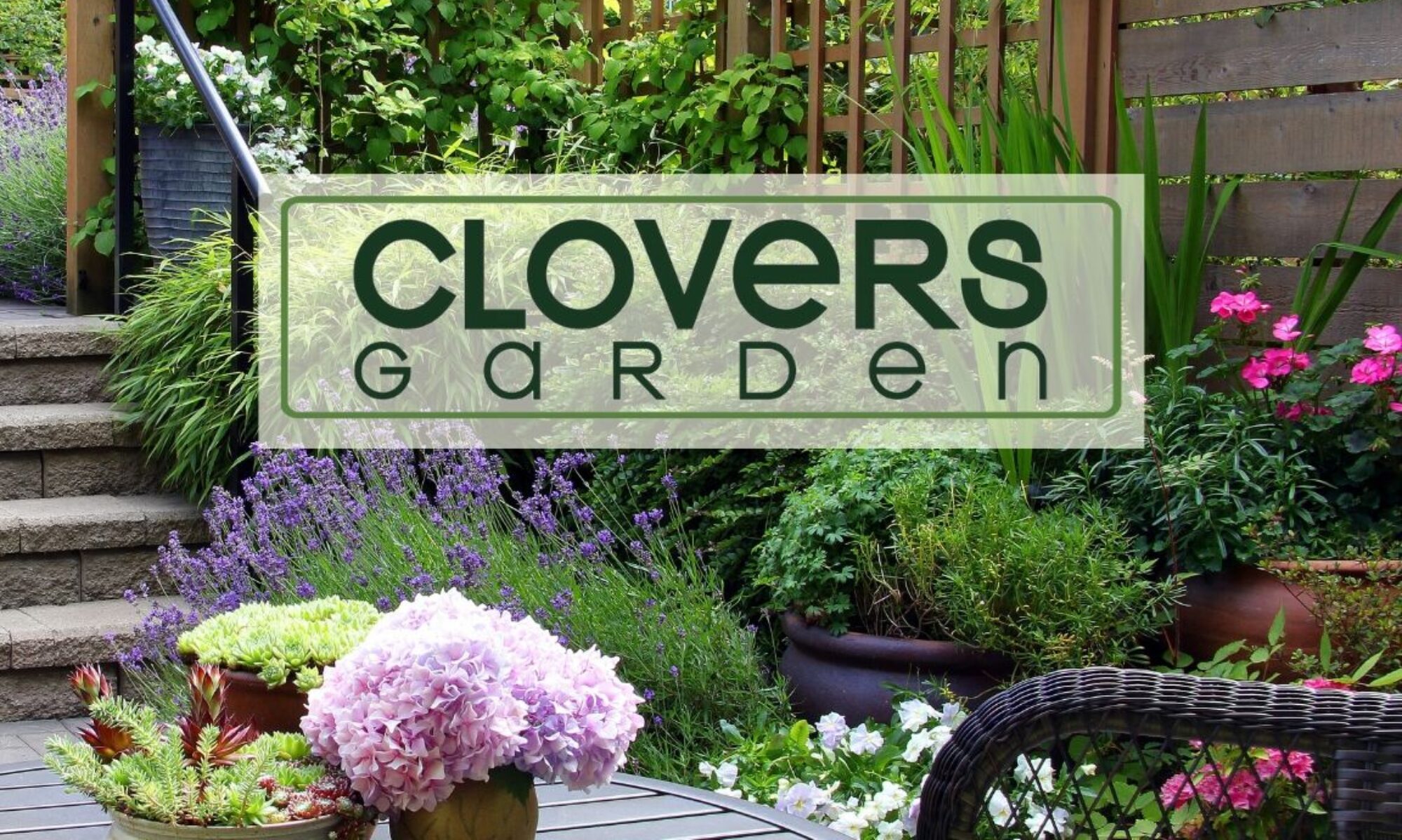
 This garden favorite is easy to grow and versatile in so many dishes, make sure you plant lots because you’ll always find a use for it! Basil can be started from seed directly in the garden but will take some time to harvest. Planting from seedling will give you quicker results. Basil prefers full sun, well-drained but consistently moist soil, and needs warmth to grow. If your soil dries out quickly, mulch around the base of the plant (be sure to choose organic mulch!). It does have a tendency to flower so be sure to trim off blossoms to promote growth (they are edible!). Not fussy, basil just needs regular watering and occasional fertilizer. The more you harvest, the faster it grows and will keep producing until the first heavy frost.
This garden favorite is easy to grow and versatile in so many dishes, make sure you plant lots because you’ll always find a use for it! Basil can be started from seed directly in the garden but will take some time to harvest. Planting from seedling will give you quicker results. Basil prefers full sun, well-drained but consistently moist soil, and needs warmth to grow. If your soil dries out quickly, mulch around the base of the plant (be sure to choose organic mulch!). It does have a tendency to flower so be sure to trim off blossoms to promote growth (they are edible!). Not fussy, basil just needs regular watering and occasional fertilizer. The more you harvest, the faster it grows and will keep producing until the first heavy frost. Mosquitoes hate the scent! Especially Lemon Basil and Cinnamon Basil – combine a few plants in your patio containers to keep the bugs away. The full foliage makes a nice addition to containers; just rustle the leaves for a burst of scent; and you’ll have ready access to herbs for dinner. Old-time gardeners always planted basil near tomatoes, peppers, and asparagus to repel thrips and beetles. Folklore also goes that basil planted near tomatoes make the fruit sweeter. Definitely worth a try and you’ll need both ingredients for our killer Caprese recipe (
Mosquitoes hate the scent! Especially Lemon Basil and Cinnamon Basil – combine a few plants in your patio containers to keep the bugs away. The full foliage makes a nice addition to containers; just rustle the leaves for a burst of scent; and you’ll have ready access to herbs for dinner. Old-time gardeners always planted basil near tomatoes, peppers, and asparagus to repel thrips and beetles. Folklore also goes that basil planted near tomatoes make the fruit sweeter. Definitely worth a try and you’ll need both ingredients for our killer Caprese recipe (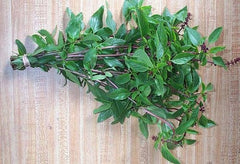 Basil can be harvested as needed but try to pick in the morning as the taste will be the sweetest. To pick, just snip leaves off the plant or cut a whole stem (the latter will cause plant to bush out more). Rinse leaves in cool water and spread on towels or use a salad spinner to dry out. If you aren’t using right away, submerge stems in water as with a flower bouquet until ready to use. Do not store in the refrigerator as this will affect taste. To strip leaves off stems, just hold upside and run fingers down the length of the branch.
Basil can be harvested as needed but try to pick in the morning as the taste will be the sweetest. To pick, just snip leaves off the plant or cut a whole stem (the latter will cause plant to bush out more). Rinse leaves in cool water and spread on towels or use a salad spinner to dry out. If you aren’t using right away, submerge stems in water as with a flower bouquet until ready to use. Do not store in the refrigerator as this will affect taste. To strip leaves off stems, just hold upside and run fingers down the length of the branch.


 Milkweed grows in a sturdy upright pattern with large leaves that turn from light green to dark green and sometimes to red as they mature. The plant can reach up to six-feet tall and produces a multi-clustered pinkish purple flower that is typically as large as a tennis ball and blooms throughout the summer, if regularly pruned. In addition to Monarchs, many other pollinators will visit these flowers so this plant does well if combined with other flowering plants. If leaves or stalks are broken, they ooze a white, milky substance which gives the plant its name. Large oblong seed pods eventually form with a hard husky shell and are often used in dried floral arrangements. When broken open, the silky seeds will float all over and can be a bit messy.
Milkweed grows in a sturdy upright pattern with large leaves that turn from light green to dark green and sometimes to red as they mature. The plant can reach up to six-feet tall and produces a multi-clustered pinkish purple flower that is typically as large as a tennis ball and blooms throughout the summer, if regularly pruned. In addition to Monarchs, many other pollinators will visit these flowers so this plant does well if combined with other flowering plants. If leaves or stalks are broken, they ooze a white, milky substance which gives the plant its name. Large oblong seed pods eventually form with a hard husky shell and are often used in dried floral arrangements. When broken open, the silky seeds will float all over and can be a bit messy.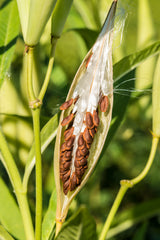 Milkweed requires full sun, light soil, and can handle drier conditions once established. This plant is also perennial (assuming you choose a variety native to your region) and spreads rapidly through a rhizome or taproot growing out from the plant. Planting just a few plants this year will eventually help you establish a large patch over time and will require some cutting back if it outgrows your flowerbed. While Milkweed will not fit every landscape design, there are many ways to include this amazing plant in your garden. Be creative and put the plant’s tall, sturdy structure to use to complement other more delicate plants. Here are just a few ideas to get you started:
Milkweed requires full sun, light soil, and can handle drier conditions once established. This plant is also perennial (assuming you choose a variety native to your region) and spreads rapidly through a rhizome or taproot growing out from the plant. Planting just a few plants this year will eventually help you establish a large patch over time and will require some cutting back if it outgrows your flowerbed. While Milkweed will not fit every landscape design, there are many ways to include this amazing plant in your garden. Be creative and put the plant’s tall, sturdy structure to use to complement other more delicate plants. Here are just a few ideas to get you started: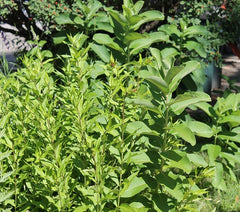 The best and easiest way is to plant a cottage-style garden. These freeform gardens typically include hardy plants such as Hollyhocks, Tall Garden Phlox, Climbing Roses, and Daisies and it’s easy to tuck a few Milkweeds into that mix. As the summer goes, each plant will flower, inviting birds and butterflies from all over. Monarchs will feed from many different plants and you’ll most likely attract lots of other beneficial insects who’ll work hard to pollinate your garden or fruit trees.
The best and easiest way is to plant a cottage-style garden. These freeform gardens typically include hardy plants such as Hollyhocks, Tall Garden Phlox, Climbing Roses, and Daisies and it’s easy to tuck a few Milkweeds into that mix. As the summer goes, each plant will flower, inviting birds and butterflies from all over. Monarchs will feed from many different plants and you’ll most likely attract lots of other beneficial insects who’ll work hard to pollinate your garden or fruit trees. Monarchs are the only butterfly known to make a two-way migration. Most other butterflies are able to overwinter as larvae or pupae but Monarchs cannot survive the cold. Relying on environmental changes, they know when it’s time to head South and will travel between 50 and 100 miles per day, taking up to two months to reach their winter home in Mexico or Southern California. They start returning to the Southern U.S. in late February, making pit stops along the way to refuel and reproduce. Over the course of the summer and their travels, they will produce four generations of Monarchs, each one travelling further North. The fourth generation does not reproduce the first year and are the ones who travel to overwinter and restart the cycle in the Spring.
Monarchs are the only butterfly known to make a two-way migration. Most other butterflies are able to overwinter as larvae or pupae but Monarchs cannot survive the cold. Relying on environmental changes, they know when it’s time to head South and will travel between 50 and 100 miles per day, taking up to two months to reach their winter home in Mexico or Southern California. They start returning to the Southern U.S. in late February, making pit stops along the way to refuel and reproduce. Over the course of the summer and their travels, they will produce four generations of Monarchs, each one travelling further North. The fourth generation does not reproduce the first year and are the ones who travel to overwinter and restart the cycle in the Spring. Not all seed starter pots are created equal! Some like plastic or peat are hard on the environment while others are not so great for the seedlings. Luckily innovators have come up with a great alternative that’s friendly to the planet and tender seedlings.
Not all seed starter pots are created equal! Some like plastic or peat are hard on the environment while others are not so great for the seedlings. Luckily innovators have come up with a great alternative that’s friendly to the planet and tender seedlings.










 Just like people, garden vegetable plants grow best when they’re with friends! If you struggle with pests, critters, or even want a better crop, companion gardening can help! For instance, did you know that bee balm and mint planted near tomatoes will enhance the flavor?
Just like people, garden vegetable plants grow best when they’re with friends! If you struggle with pests, critters, or even want a better crop, companion gardening can help! For instance, did you know that bee balm and mint planted near tomatoes will enhance the flavor?  o, knowing your garden helps determine the problems that need fixing (for instance, not all gardens have trouble with cutworms). The easiest approach to companion gardening is to plant flowers and veggies in a haphazard way. No long rows, no big patches of one plant, just all jumbled together in your plot. This confuses insects and critters as they’re looking for their favorite treat and effectively camouflages plants from their enemies!
o, knowing your garden helps determine the problems that need fixing (for instance, not all gardens have trouble with cutworms). The easiest approach to companion gardening is to plant flowers and veggies in a haphazard way. No long rows, no big patches of one plant, just all jumbled together in your plot. This confuses insects and critters as they’re looking for their favorite treat and effectively camouflages plants from their enemies!
 Always wear gloves – all parts of the pepper are hot but the inside membranes and juices are the hottest. Even with gloves on, don’t touch your face, eyes, or nose. Keep milk on hand, too, as it will kill the burn much faster than water. Along with heat, each pepper has a unique flavor and color. Bell peppers have sweet and meaty flesh and are perfect for crunch and color; rubbed with olive oil and grilled whole; or sautéed and added to tomato sauce. Their sweet flavor and pretty colors only intensify if left on the vine to turn from green to yellow to orange to red. Chile peppers, too, come in a wide range of colors and the less hot versions can be made into lovely relishes, pickled with onions, or added to burgers or shishkabobs.
Always wear gloves – all parts of the pepper are hot but the inside membranes and juices are the hottest. Even with gloves on, don’t touch your face, eyes, or nose. Keep milk on hand, too, as it will kill the burn much faster than water. Along with heat, each pepper has a unique flavor and color. Bell peppers have sweet and meaty flesh and are perfect for crunch and color; rubbed with olive oil and grilled whole; or sautéed and added to tomato sauce. Their sweet flavor and pretty colors only intensify if left on the vine to turn from green to yellow to orange to red. Chile peppers, too, come in a wide range of colors and the less hot versions can be made into lovely relishes, pickled with onions, or added to burgers or shishkabobs.